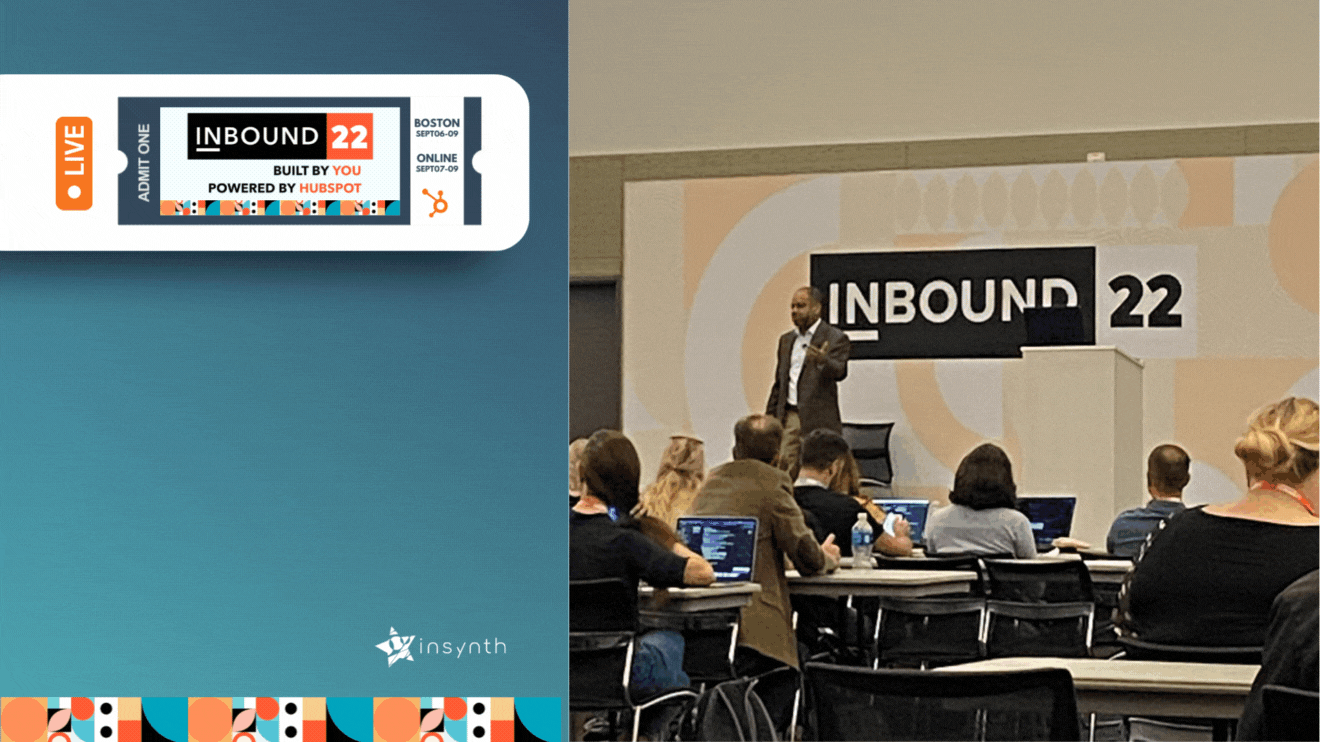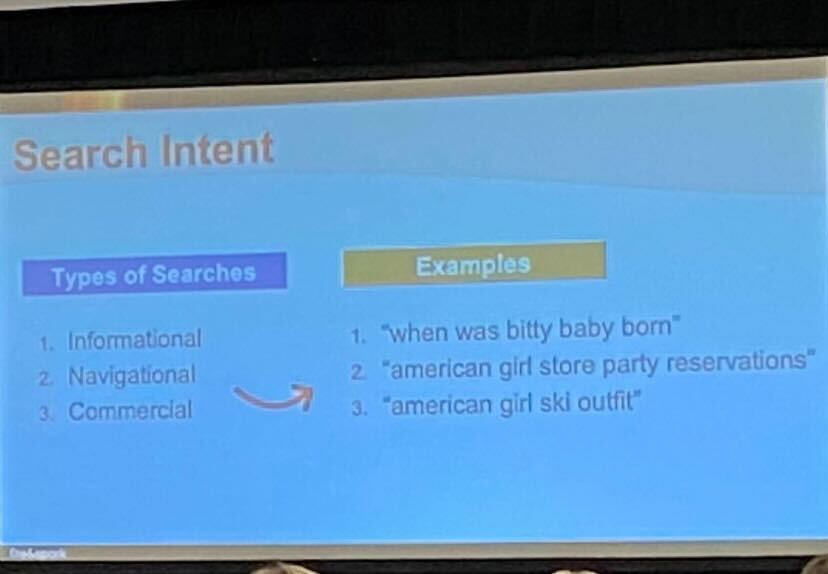5 min read
#INBOUND22 How Great Brands Scale SEO: A Behind The Scenes Look
![]() Henry Jones
:
08-Sep-2022 15:25:00
Henry Jones
:
08-Sep-2022 15:25:00

LIVE FROM #INBOUND22
“Has your organic traffic plateaued?” A great question asked by Dale Bertrand, President at Fire & Spark in his talk at INBOUND22. Dale is someone who I had the pleasure of listening to at BrightonSEO back in April. This time in Boston, he’d be covering scaling SEO as your company grows, and using examples of how some of the best have done it previously.
Dale Bertrand has been an SEO specialist for Fortune 500 companies and venture-backed startups around the world for two decades. His clients include global brands such as Citizen Watch, Nestle, Raymond Weil and Bulova. He applies his graduate school work in artificial intelligence to search engine marketing and he speaks at many industry conferences and leads corporate training events.
In this session live in Boston, MA, Dale laid out a step-by-step framework for scaling organic traffic, based on a dozen face-to-face interviews with experienced SEO practitioners who have generated organic traffic on a global scale.
He began by explaining that typically, marketing teams focused on SEO "best practices" struggle to maintain strong organic traffic growth. This is something you may have seen for yourself at your own business.
Dale pointed out that a dual SEO strategy, one that pushes us to think from both a bottom-up and top-down perspective will lead to the greatest results. A top-down approach is marketing strategy-led and comes from the goals of both your business and your sales and marketing teams goals. Whilst a bottom-up approach is content-led and looks to determine the content we produce by the opportunities we have to score backlinks, etc.
But here’s how the big companies who lead the way in global industry’s managed to scale their SEO practices to stay on top of the competition. Search marketers at these top brands, including HP, IBM, and Kraft all tell the same story. That is that building on their previous SEO success is often much harder than achieving your first organic clicks. Scaling massive organic traffic, beyond the honeymoon phase of implementing SEO & content marketing, requires a different set of SEO strategies and allocation of resources that go far beyond traditional "best practices."
Google's AI Algorithm
To understand the first strategy for making this possible we first must understand what Google used to be and what it is now. Google shifted from a rules-based algorithm (e.g SEO best practices) to an AI algorithm (e.g training determines the rules that Google follows).
Why did Google switch to an AI algorithm?
- Better Results
- Learning Algorithms
- Scaling is Easier
- Faster Updates
- Training by Humans
You can see old vs new google by searching for your keyword and putting it in quotation marks and seeing the results, this is how old Google works, it looks for the exact words on the page. Then try searching it without the quotation marks and you will see how different the results are, this is the algorithm in action.
AI-based Google means we need to understand the training that the algorithm is given because we don’t get told the rules anymore. In fact, even google engineers don’t know what the rules are. This leads to a key point that I’d like to highlight.
There’s no easy way to figure out why the top 10 on a SERP are the top 10.
Why is this? Well, Google is a prediction machine. It makes a prediction based on the intent behind the search query and AI helps it to do this. AI helps by continually learning. The meaning of terms can change over time so the algorithm needs to learn the intent behind the search as the meaning of the words changes.
Answer Customer's Questions
Dale’s next strategy was to ask ourselves 2 questions, the first question was: What questions do our customers ask? Then we should ask ourselves: What information do our customers need? Then we need to put the answers to these questions on our website and don’t hide the answers even if we may, at first want to, even if it is things such as price, or process.
Keyword Intent
The third strategy in Dale’s talk on scaling SEO is to consider intent. He made a great point that any one keyword has multiple intents behind the search. Here are 3 types of intent that a search could keyword could have:
- Informational
- Navigational
- Commercial

The difference in the keyword can be very small but it can change intent dramatically, for example, the keywords 3D Printing vs 3D Printer, have very different intents.
As converting organic traffic is the end goal of any SEO strategy we need a plan of how to convert this traffic. Dale’s approach is to show your “traffic” the content that they “intended” to find when they but their search into Google and the result will be you (hopefully) convert them. But how can we understand what the intent is? Well, exposure to real customers helps you to understand the intent and context behind the things they search for and then create content to match this.
Dale then talked us through 3 useful SEO tools. SEO tools are evolving as the algorithms do, they’re beginning to employ the same technologies used by Google’s algorithms.
SEO Tools
Here are 3 Examples of SEO Tools that Dale recommends:
- TwinWord – AI that labels keywords – highlights the intent behind a keyword
- Surfer SEO – AI content editor
- Word Lift – adds scheme to your article – tags the concepts that you’re talking about in your content
Experiment with tools then keep or delete them, ask yourself, what tasks do I do, which can be improved and then get tools that can help you.
Tips for AI SEO
Dale gave some really useful tips for AI SEO
- Consolidate your mid-performing content into larger guides, this works especially well if you have lots of content
- Add the current year to your guides
- Answer people also ask questions
- Add internal links to new content
- Add schema mark-up to your site
- Add video and images to the top of an article
Optimizing your content for new SERP features was another of Dale's strategies for scaling SEO. Study the SERP to see what appears for your keywords then optimise content to appear in that type of SERP feature eg, a featured snippet, video, shopping, google my business, or FAQs. Dale pointed out that for his clients he does a lot of question and answer content as this is working well for him right now.
Q&A
And finally, Dale answered a few questions from the audience.
Q: Should we optimise for featured snippets?
A: SEOs can dislike it because it prevents traffic but if you get the featured snippet it is a cheat code to be the number 1 spot.
Q: Any tips for low/no volume keywords?
A: If people aren’t searching for something then search marketing isn’t where your resources should go. If there’s no volume or demand or intent then search isn’t the tool for you.
Q: I have multiple buyer personas visiting a page, which do you optimise for?
A: Well, which do you care about the most? If you care about them all then select one as primary (value, authority, first conversion) and optimise for that one. Then make it obvious where other personas should click to find their targeted page.
Q: How should I build my pages?
A: Build your pages based on the topics/concepts people are searching for, then separate them by product and persona secondary
Q: How much attention should I pay to page speed?
A: Core web vitals is a ruse, it was invented because Google was scared people would use apps instead of Google. It is only relevant if it tells you your page is very broken e.g. page load speed over is over 1 second
Conclusion
It was great to see and hear Dale talk for the second time this year. Scaling SEO is a challenge facing many businesses and utilising AI to overcome the problem is a great solution to growing your SEO strategies. I will be putting the things I learnt today into practice as soon as I can and can’t wait to see the results.
